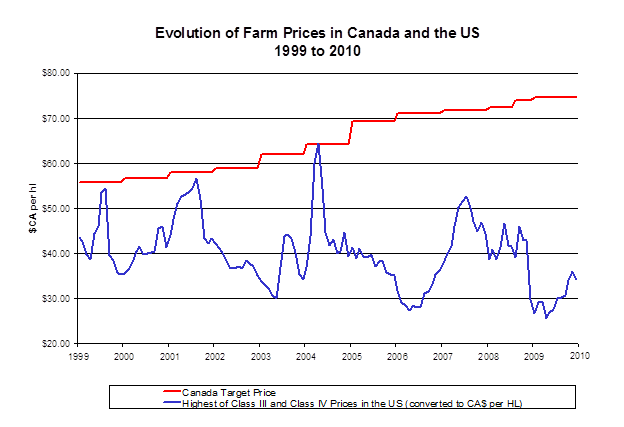From the “milk wars” in the 1960’s that established Canada’s supply management system to the various rounds of World Trade Organization meetings, Canada’s quota system has always been a contentious subject for many reasons. We decided to look at the issue from an animal breeding perspective. We are not trying to analyze the pros and cons of the quota system, but rather what it means for dairy farmers’ breeding programs.
Various rounds of world trade talks have touched on this issue but, similar to US subsidies, it seems that even though they are counter productive to world trade, no one wants to broach this issue. With that, we found that it has the following three effects on Canadian breeder’s genetics programs:
- Limits Entry to Market
Because farmers need to own quota in order to ship fluid milk, it limits who is able to produce milk. Often times in a new operation the cost of quota is the single largest capital investment in starting a new dairy. This greatly restricts herd size as well as often times this means that the next generation of dairy farmers have to go work in other industries in order to build enough capital in order to enter the market. Many times these individuals never come back and are a true loss to the dairy industry. Those that have the smarts to excel in other industries end up doing great things in other markets instead of helping advance the dairy breeding industry. - Provides Stables Pricing
While the world price for milk saw a significant drop in late 2008, due to Canada’s supply management system Canadian dairy producers did not directly feel that effect. This meant that Canadian breeders could continue to run their programs as if nothing had changed. But many top breeders who’s “genetics” check is either the yearly vacation fund, or others whose genetic sales represent the majority of the farm’s profit, saw a significant drop in fresh heifer and even high end genetic sales to their major market, the US. “Big deal!” you may say. Actually, this was very significant. Having just come out of the BSE turmoil, Canada was looking to rebuild their world export markets and for many breeders their programs are not won or lost on the value of what the top animals sell for, but rather the cost of recipients. With a low price for fresh heifers, many breeders went from making a profit on their recipients to taking a significant loss. So while the quota system helped protect them on their milk check, nothing could help them on their genetics check through this period. - Promotes Inefficiency in Production
Any smart breeder knows how to breed for maximum profitability however, with a stable milk price that is higher than world market price, many Canadian producers have not been forced to maximize the efficiency of their dairy operations. Peter Slade found that when comparing Ontario Dairy Farmers operations to New York dairies that New York farmers where up to 17.5% more economically efficient in their milk production. This efficiency did not only come from their operations alone but also their breeding programs. Because New York dairies are forced to look as every aspect of their operations and look how they can maximize revenue, their mating programs are substantially more geared towards efficient milk production than that of Ontario operations. Canadian breeders have been able to focus on type more significantly for many years, and hence their distinct advantage in this area.
The Bottom Line
The quota system has been both a gift and a curse to Canadian dairy farmers. There is no question when you look at the big picture that the quota system has been great for dairy farmers. However, when it comes to their breeding programs, it has had a bias and limiting effect. Granted, it has allowed breeders to focus much more on type and breeding the Canadian kind, but, at the same time, it has also built a false market security and therefore, there has not been as much focus on production and efficiency that other markets have been forced to address. The real advantage comes for many dairy operations when both opportunities are recognized and maximized by the savvy Canadian dairy breeder.
What do you think? Share your comments below.



















In the US it is easier to enter the market…. milking cows in a rented barn for example. It is also easy to go bankrupt… when milk prices drop and costs increase.
We see lots of American tourists on our farm,and I recently tried to explain the benefits of our quota system to a Texas dairyman. He also explained his theory.lol essentially if milk prices fall,so does his net income per cow.he will milk however many more cows it takes to keep funding his Canadian vacation.if that over supply keeps depressing prices he will do anything he can to lower his costs/increase efficacy and hopefully outlast enough of his neighbors to see prices recover. The picture graph above of the u.s vs can milk prices pretty much says it all.
It would seem the UN and WTO are both more harm than good.
I guess it would depend on what side of the coin you are on. I know that in Canada softwood lumber is a touchy issue.
I’m curious…if Canadian genetics are so inferior, why are they such a hit in Asian markets?
Who said they where inferior? What we are pointing out is that the perceived advantage to the supply management system, really does not do that much in the genetics market.
Would you not say that with the cap on quota that it has forced producers to be come more efficient if they want to make more money?